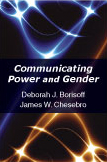Introduction
Defining Gender, Power and Communication / A Historical Foundation for Examining Gender and Power as a Communication Process / Gender and Power Issues in the Second Half of the Year 2009 / Organization of This Book
1. The Stereotype: Fiction or Fact
Stereotype as an Awkward Term / Sex-Role Stereotypes: Feminine and Masculine Preconceptions / Changing Conceptions of Sexuality: The Emergence of Androgyny
2. Verbal and Nonverbal Face-to-Face Communication by Gender
Basic Elements or Structural Features of Verbal and Nonverbal Communication / Verbal and Nonverbal Communication as a Process: Stages in the Development of an Interpersonal Relationship
3. Mediated Communication and Gender Roles
The Pervasiveness of Media Systems in Our Daily Lives / Determining and Measuring Media Effects: Minority Masculine and Feminine Images as a Case Study / Masculine and Feminine Individuals and Images in Films and Music / Gender Roles in the World of Television / Masculinity and Femininity on the Internet
4. Early Socialization in the Home: Influencing Gendered Scripts
The Impetus for and Effects of Dichotomizing and Valuing Behavior / Socialization: Reinforcing Attitudes about Sex Traits and Sex Roles / Age as a Marker for Creating a Life / Competing Roles as a Marker for Creating a Life
5. The Educational Landscape: Connecting Gender and Identity
The Environmental Gap: Socioeconomic Status and Communication in the Home / The Academic Gender Gap: The Power of Assumptions, Expectations, and Attributions / The Impact of the Invisibility Gap on the Classroom Climate / Closing One Gap, Opening Another
6. Gendered Scripts: Women and Men in the Workplace
Maintaining the Myth of "Women's Work" and "Men's Work": The Impact of Stereotypes on Job Choice and on the Interview Process / The Impact of Stereotypes and Discrimination on Hiring Practices / The Impact of Difference on Organizational Assimilation and Retention / The Discourse on Work/Life Balance: Impact on Attitudes and Decision That Maintain Gender Differences / Prospects for Altering the Workplace: Challenges and Recommendations

234 pages, $35.95 list
1-57766-690-9
978-1-57766-690-5
© 2011
paperback
eBook availability
Communicating Power and Gender
As a perceptive and outstanding assessment, Communicating Power and Gender examines the relationships between gender and power and how they are linked to and transformed by the communication process. Within this discussion a host of correlations emerge, crossing social, cultural, historical, political, and racial spheres. In order to anchor their discussion Borisoff and Chesebro define the terms gender, power, and communication, which provides an operational platform from which to view fundamental issues such as the effects of stereotyping and verbal and nonverbal communication by gender. The authors also consider four contexts that shape and influence gender socialization and sex-role constructions: mediated communication and gender roles in various media systems, early socialization in the home, the educational landscape, and women and men in the workplace.
Our environment continually generates new kinds of questions and associations. The more we interact with others the more we realize that our relationships are not fixed—they exist in a state of flux. Communicating Power and Gender explores not only how gender-based issues affect us daily, but also how gender-based communication can be more sensitively, usefully, and effectively employed.
Our environment continually generates new kinds of questions and associations. The more we interact with others the more we realize that our relationships are not fixed—they exist in a state of flux. Communicating Power and Gender explores not only how gender-based issues affect us daily, but also how gender-based communication can be more sensitively, usefully, and effectively employed.